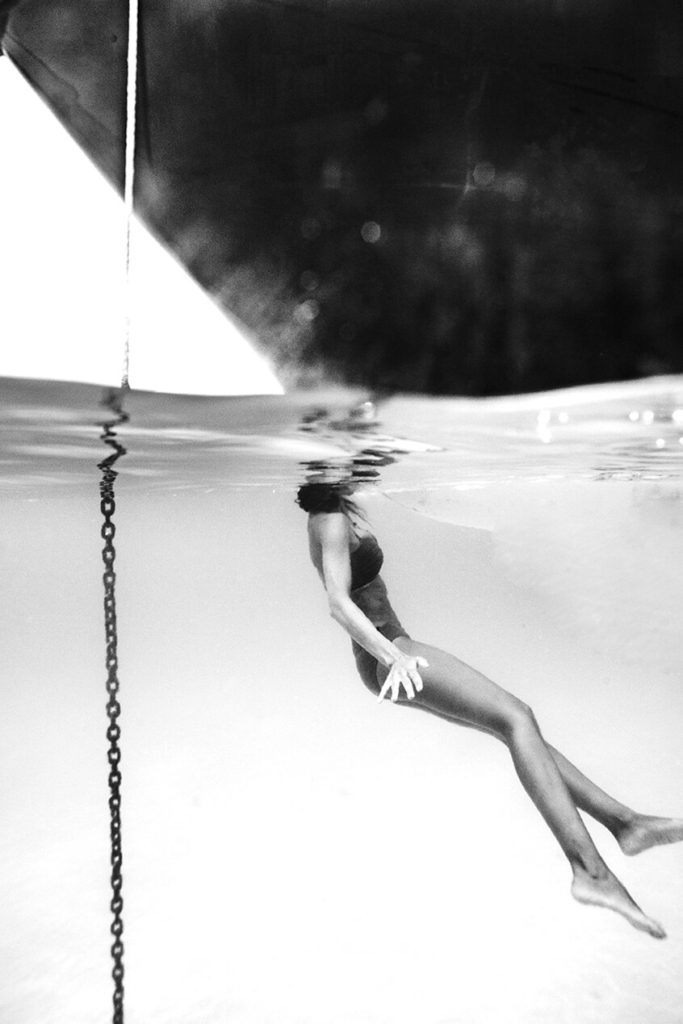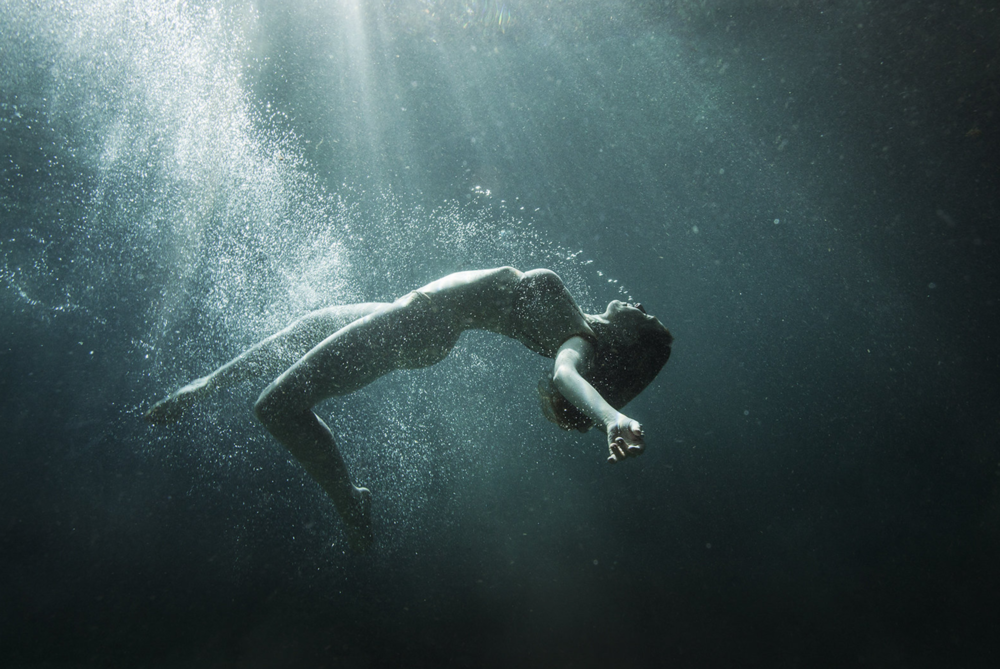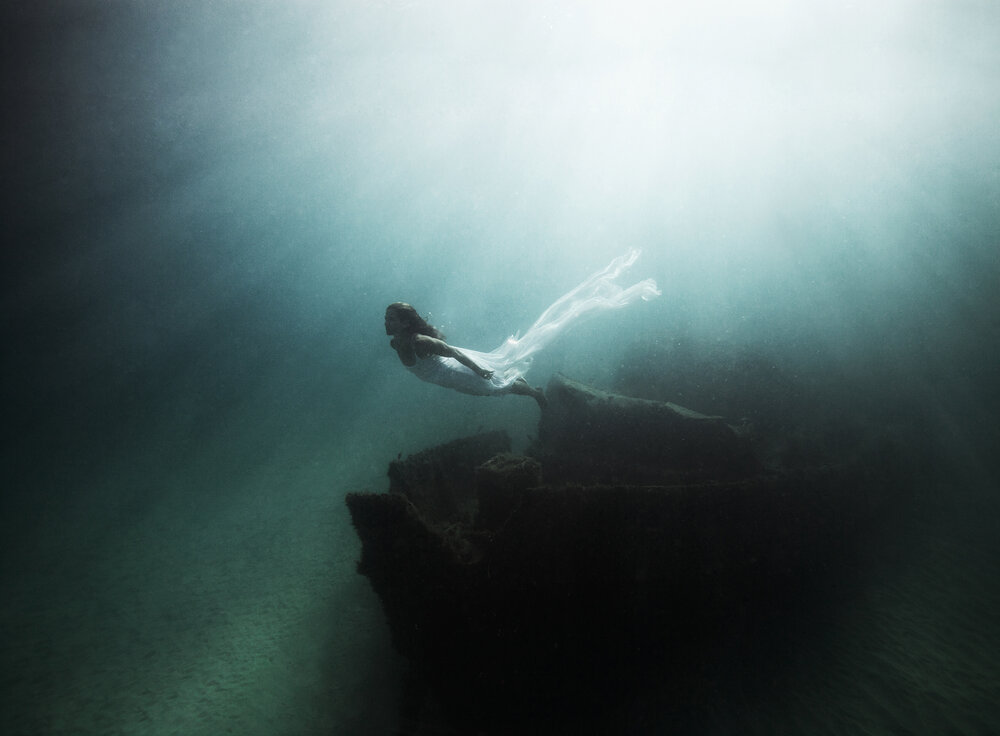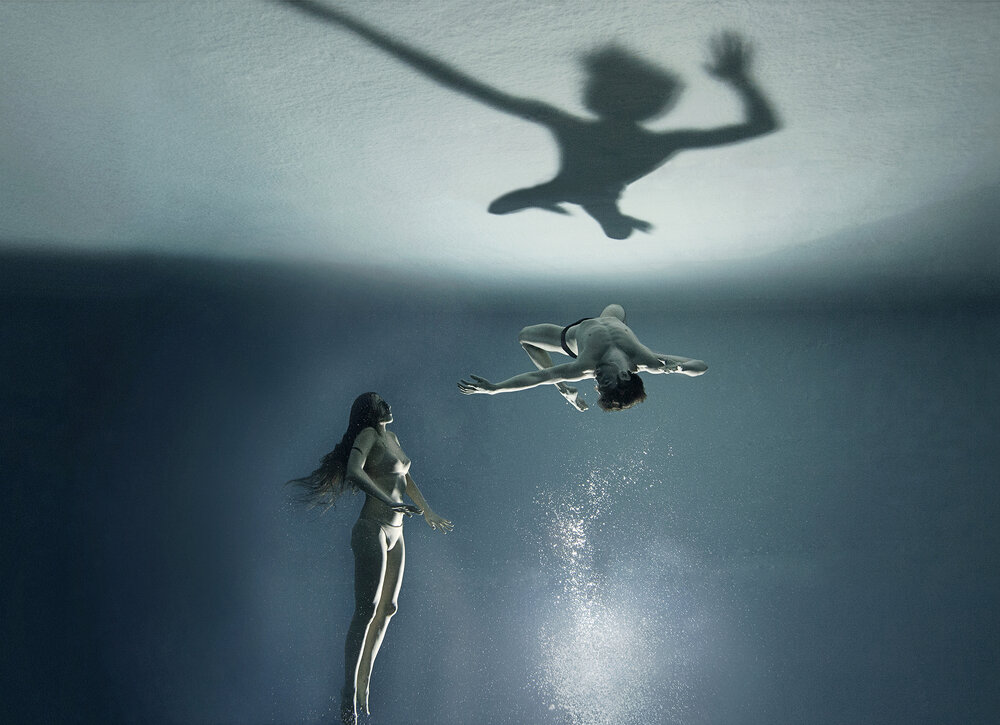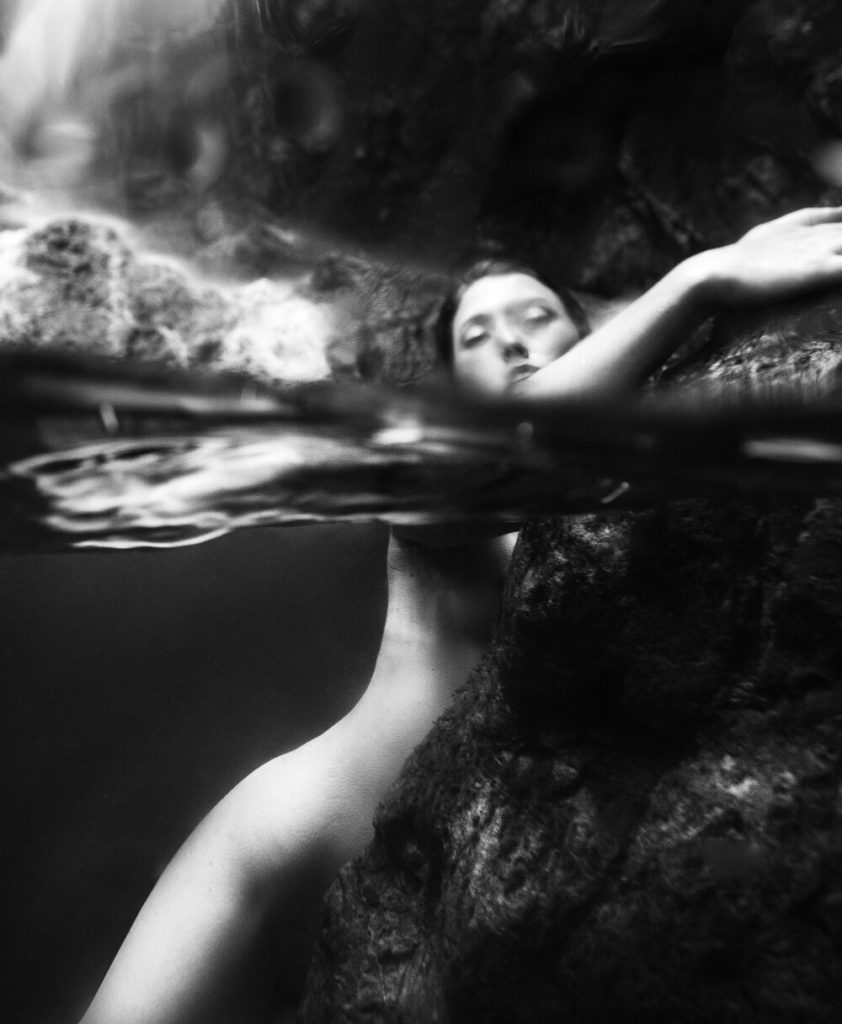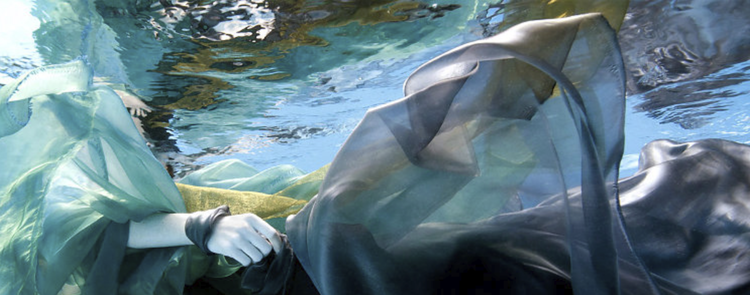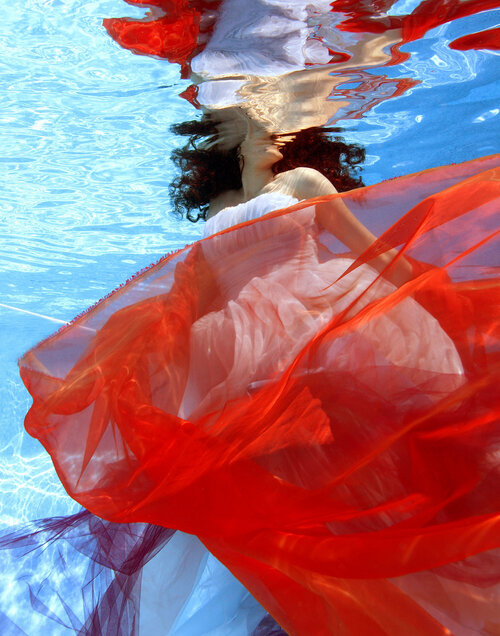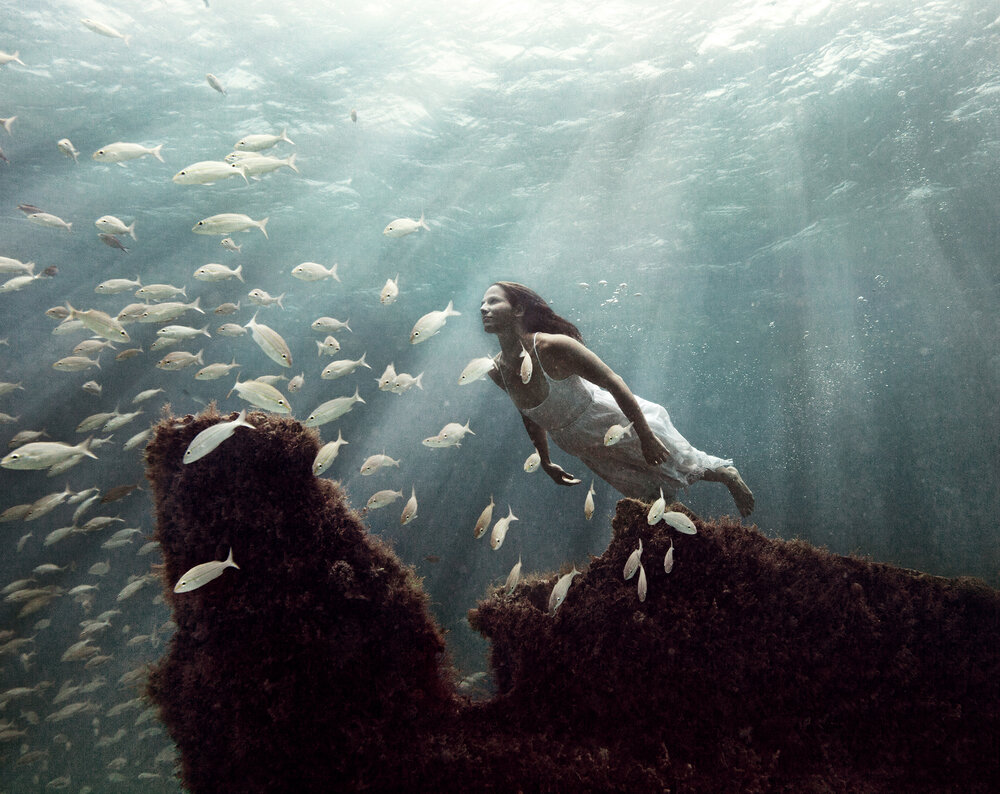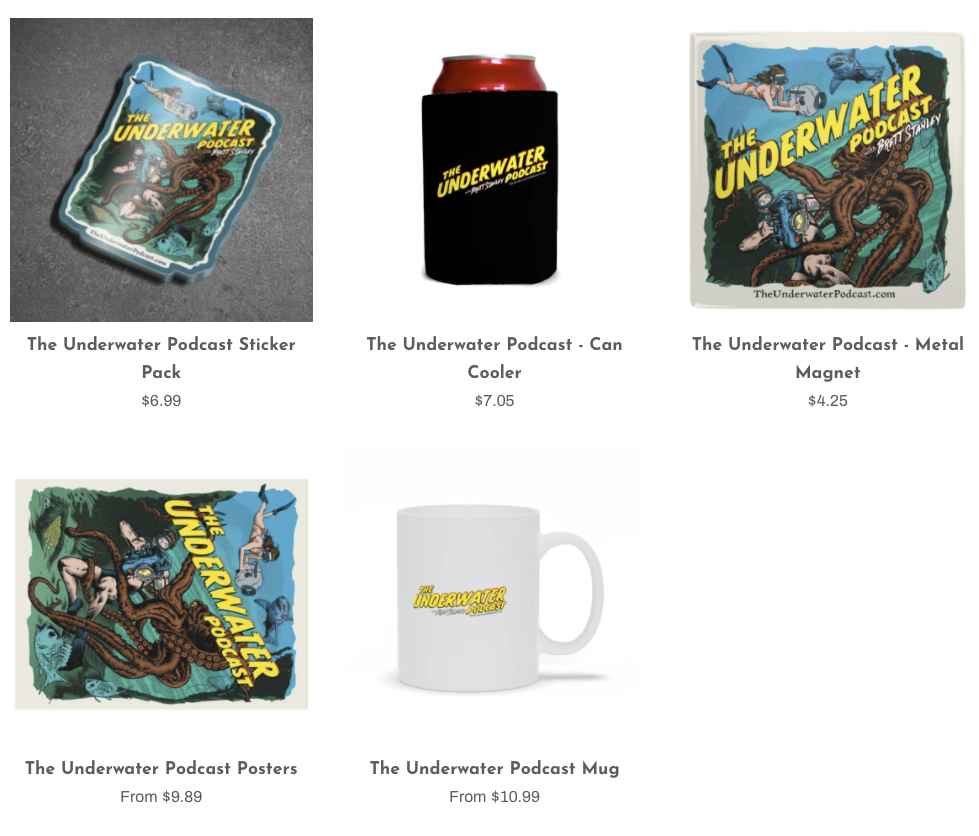Fine Art Photographer Meghan Ogilvie
In episode #37, host Brett Stanley chats with Canadian photographer Meaghan Ogilvie. Meaghan is an underwater fine art photographer, and whilst based in Toronto she travels quite extensively and creating beautiful underwater images as she goes. She’s shown her work in galleries worldwide, and we talk about what that process is like and how the pandemic has change that landscape.
Meaghan shares her visions of the future and we talk about what it’s like to spend a few weeks on a sailboat with other underwater artists.
Follow this guest: Website, Instagram, Facebook
Discuss the episode in our facebook group.
About Meaghan Ogilvie – Underwater Fine Art Photographer
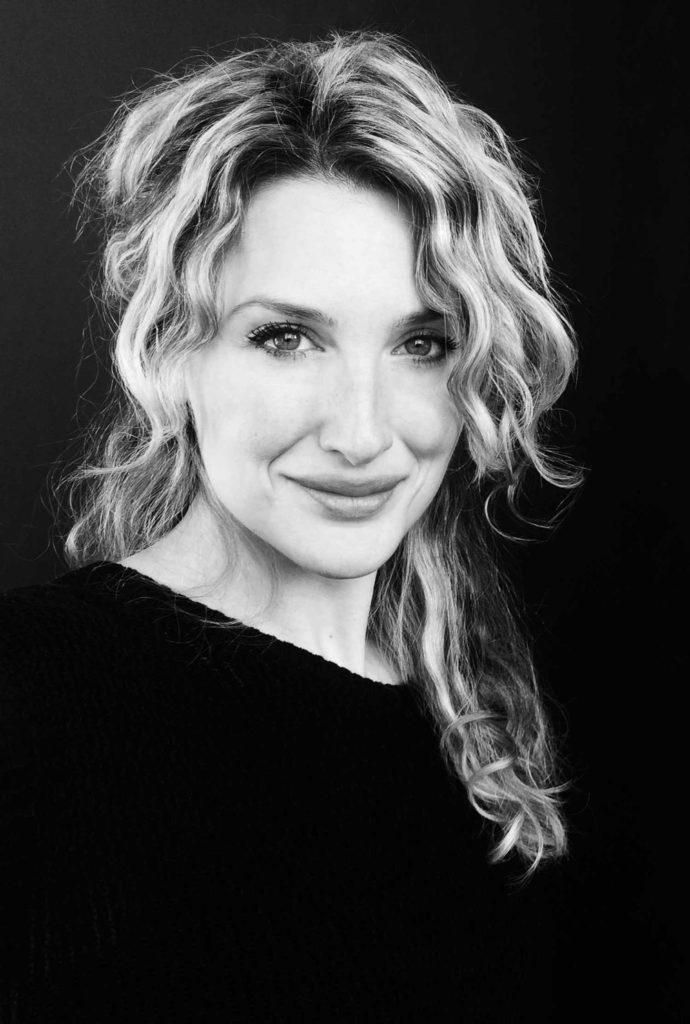
Meaghan Ogilvie (Toronto, Canada) is an internationally recognized Photographer and visual artist whose diverse artistic collaborations are often aimed at raising awareness about water conservation. She has specialized in underwater photography for the past twelve years and is sought after for her unique style, skillset and sense of adventure from collectors and clients. She has received numerous acclaimed awards and her work has been exhibited across North America and Europe. She has been accepted to art residencies at New York City’s School of Visual Arts, Vancouver’s Art Tahsis, France’s sailing residency aboard Diatomée in the Caribbean and Toronto’s Artscape Gibraltar Point. Her work has taken her diving around the world and has connected her with incredible opportunities. From collaborating with Indigenous women promoting the necessity of the great lakes, to diving in Palau, an archipelago of islands in Micronesia, and receiving a commission by the Toronto 2015 Pan American Games to create a large-scale exhibition—“Requiem of Water”—for the event’s arts and culture festival. Meaghan was named one of “10 Canadian Photographers You Should Know” alongside artistic talents Edward Burtynsky and Paul Nicklen. She has been invited to speak at several events including the Creative Minds Panel alongside Director Atom Egoyan on Salt Spring Island in Vancouver.
Podcast Transcript
Ep 37 – Meaghan Ogilvie
Brett Stanley: [00:00:00] Welcome back to the underwater podcast. And this week I’m talking to Canadian photographer, Meaghan, Ogilvie . Meaghan is a fine art photographer. And whilst based in Toronto, she travels quite extensively creating beautiful underwater images as she goes.
She’s shown her work in galleries worldwide. And we talk about what that process is like and how the pandemic has changed that landscape. Meaghan shares her visions of the future. And we talk about what it’s like to spend a few weeks on a sailboat with other underwater artists. All right. Let’s dive in.
Meaghan, welcome to the underwater podcast.
Meaghan Ogilive: [00:00:33] Hi, thanks so much for having me.
Brett Stanley: [00:00:34] How are you doing Europe in in Toronto at the moment, right? So it’s you probably like cold,
Meaghan Ogilive: [00:00:40] I’m freezing. I think it’s minus nine today. So there’s no diving right now for me.
Brett Stanley: [00:00:45] right? And that’s minus nine centigrade.
Meaghan Ogilive: [00:00:48] Yes. Yeah, it’s freezing.
Brett Stanley: [00:00:50] Yeah. Amazing. Yeah. Do you, do you tend to do stuff during the winter up there? Yeah.
Meaghan Ogilive: [00:00:56] Um, Usually I travel in the winter and because of COVID, that’s not happening, so I’m really adapting to all the winter sports. And so there’s a lot of hiking and snowshoeing and yeah. Tobogganing, stuff like that.
Brett Stanley: [00:01:10] So, so where would you be at this time of year? Where do you normally, do you sort of travel to the same places or are you sorta just going wherever it takes you every year?
Meaghan Ogilive: [00:01:17] Wherever it takes me. Yeah. I like the spontaneity of it.
Brett Stanley: [00:01:20] right. And are you w are you traveling for work? Like if you’ve got clients you’re traveling for, or are you just a, sort of a self traveler and then sort of shooting as you go.
Meaghan Ogilive: [00:01:29] Mostly a self traveler, but there are opportunities that have come up for sure. To travel for work. And I’m working on getting more of those after COVID hopefully. So, but I, I love traveling. So as much as I can, I’ll do it on my own dime just to experience different places, different types of water from like to, the sea or the ocean or in different parts of the world.
I think it really helps with my underwater photography.
Brett Stanley: [00:01:56] Yeah. I mean, your photography is very it is almost kind of quite, quite location-based, right? Like it has a very open water feel, whether it’s, whether it’s sonatas or whether it’s lakes or whether it’s the ocean. Is that something that you set out to do? Or is it, is it just something that’s evolved from you traveling?
Meaghan Ogilive: [00:02:12] it’s definitely been a gradual progression because I did start photographing underwater and pools. And after I think about three or four years of that, I became, a bit bored and I wanted to be challenged. So at the same time I was starting to travel more and getting in the ocean. And so it just started to evolve within.
Diving and then free diving and then it just kept progressing.
Brett Stanley: [00:02:37] Right. Yeah. And what sort of timeframe are we talking? Like how long have you been shooting under waterfall.
Meaghan Ogilive: [00:02:42] For, it feels like a while. Now. It as well, since 2000, I feel old, but since 2007, I believe
Brett Stanley: [00:02:49] And so what started that? What was the catalyst.
Meaghan Ogilive: [00:02:51] My dad had a disease that it was quite rare. So I was trying to find a project that I could work on and create images that were really aesthetically different and striking. So I could use the images to hopefully grab people’s attention and talk about his disease. And so around that time, underwater photography wasn’t as accessible, I guess, as it is now, just in terms of the equipment you can, you can acquire.
And especially in Toronto there there’s a lot of American companies who come here to film and do movies, but, when I asked around there was no, like there were no tanks, there was nowhere to really accommodate an underwater shoot in the way that I envisioned it. So, And so I just did all this research and I realized I have to invest in an underwater housing if I wanted to do underwater images for this project for my dad, because I felt that underwater images would be just the most impactful and. And yeah, so I literally jumped in the pool with some friends friend who’s a stylist and a dancer, and we just created as we went, never having experienced or anything. And the images did come out striking and I was able to use the work to talk about my desk disease and that first and only shoot became the catalyst to use the beauty of my work, to talk about issues that are important to me.
And it really was the momentum to start my career and to move it forward.
Brett Stanley: [00:04:15] That’s amazing. And cause your, your career has kind of involved a lot of conservation topics and, and, and, and other things as well. Is that right?
Meaghan Ogilive: [00:04:22] Yeah. It’s, it’s mostly, I’ve tried to collaborate with a lot of conservation organizations. And also I did a project in 2015 with collaborating with indigenous women to show. And to appreciate how other cultures view water. And that was a really important, impactful time for me with my work.
And just personally, I learned about water, how it’s important spiritually to other cultures and, yeah,
Brett Stanley: [00:04:49] And so with that one, how did you kind of come up with that idea of, joining those two things together that, that kind of indigenous kind of culture and water at the same time?
Meaghan Ogilive: [00:04:59] Again, that kind of happened organically where I had been spending time just because I want to understand more clearly or clearly our connection to nature. And so I was spending time at a. An organization in Toronto. And they would, it was indigenous peoples and they would teach about their culture and you could sit in and and just listen and observe.
And so I was doing that at the time. And then I was approached about doing an exhibition for the Pan-Am games. And so the two came together and their theme was water. So it all made sense and to another, yeah,
Brett Stanley: [00:05:32] That’s amazing.
Meaghan Ogilive: [00:05:34] that was great.
Brett Stanley: [00:05:34] And so w what gear did you start using when you uh, when you sort of started, did, was it stuff that you already had, or did you have to go in and find stuff?
Meaghan Ogilive: [00:05:42] Um, I definitely had to do a lot of research on the underwater housing and I invested in purchased one. There was nothing available here in Toronto. So I was just used I think it was I don’t know which maybe it’s just the five D Canon five D and, I think I borrowed. Half of the money from a boyfriend at the time.
And I paid him back and so I was able to purchase it and, yeah, that was very helpful. And and then just experiment with it from there. So.
Brett Stanley: [00:06:08] how, how hard did you find the learning curve? Was it, it wasn’t something that you were Did you like the challenge of it or was it more kind of, I need to do this to get the result in mind.
Meaghan Ogilive: [00:06:17] I absolutely loved the challenge of it. I like being very active, so it was a way for me to move around a lot in a new way, you know just moving so. I’m not, I don’t say that I moved eloquently, but like, just following, along with the model, moving in a very streamlined way and having a rhythm with them was something that I really, I never experienced before.
So it was, I became quite addicted to that and just being outside and, and really using the elements to create the work. I really loved doing that.
Brett Stanley: [00:06:47] Right. Yeah. And what sort of people are you working with? Cause you said your first person was, I think it was a dancer. Did you kind of stuck with that sort of sort of technique with, with your other models and a, your in your other talent?
Meaghan Ogilive: [00:06:58] for the most part. Yes. Just for their, obviously their ability to, to really have control of their body. But I’ve, I’ve worked. I like working with really anyone. I think anyone can, once anyone’s in water, they do become just more free and relaxed. So, I’ve worked with non-dancers and, but for the majority of my work it’s athletes or dancers,
Brett Stanley: [00:07:21] And what are you doing to, to prepare them for it? Have they done an underwater stuff before, or is this new to them as well?
Meaghan Ogilive: [00:07:28] A lot of the time it is new for them. So usually we take like the 15, 20 minutes to just get in the water together and just, you know, get a sense of it. See like how we, how we work together, how they, how they move underwater. And then, and then we go from there. But it depends too, if it’s, if I’m, if I’m setting up a Shaun and it’s that kind of environment, and there is like a lot of back and forth, but if I’m just in.
The ocean and I’m following someone I’m documenting it, which I think I prefer doing now this time in my career then, that I’m, I’m really, I’m just trying to keep up and like anticipate movements and directions, emotions, and light and everything.
Brett Stanley: [00:08:08] Yeah. Cause I think your, your kind of more recent work has a little kind of editorial. Documentarian style to it, as opposed to something that’s been crafted, would you feel that way?
Meaghan Ogilive: [00:08:18] Yes, I definitely I think in the beginning, the aesthetic for me was really important in terms of the styling and, and all of that. But. Over time, especially after working with and collaborating with the indigenous women, it became more about stripping away, a lot of the aesthetics and, or the styling and getting more into a raw place.
And, and that’s, that’s what I think I prefer is just observing and, and rather than using, I think also in my work, I use one image as escapism and the stories in the one image. And now I’m. More interested in and focused on creating a series of images and storytelling in that way.
Brett Stanley: [00:08:58] Yeah. And you tend to use quite a lot of black and white, like monochrome. Is that, is that something that you’re thinking about while you’re shooting or is that a very much a post-production kind of design,
Meaghan Ogilive: [00:09:07] I think it might, for me, I think it’s both, it depends on where I am when I’m doing a work with the light is like But I, I think I’m coming out of that now. I’m not sure, but I have to say that I spent some time with 27 millimeter and Rick Johnny from he’s on Instagram and obviously, and Alex and , on their sailboat on DIA, Tomi.
And. On that trip. I learned a lot and I think that’s where things for me started to shift a bit and there they had both their styles and the way that they work, both influenced me in a way. So I think after that point in 2018, I believe is when my work started becoming a little bit more editorial and somewhat graphic and yeah.
Brett Stanley: [00:09:55] That’s great. Yeah. So, so were you influenced by those guys on the boat as well? Or was it just the experience of, of, of that trip that kind of changed you a little bit?
Meaghan Ogilive: [00:10:04] Oh, it was definitely all of it. Yeah. That trip. It definitely, it changed. My perspective on life, like what was important to me and just being on the ocean. I mean and seeing how like Enric, he, he lives by the ocean. He’s in the ocean every day. That is, that’s how he creates his work. He’s constantly.
Immersive, literally immersed in his work and Alex and Meliana, they they’ve dedicated, they’ve made big choices and dedicated their life to being on the water by buying a sailboat, which they were fortunate to do. And so that really inspired me to really look at my life and if what I wanted to do and how much more dedicated I want to be to a underwater photography and enhancing my skills and.
And also obviously aesthetically, it just, I didn’t even know it was happening, but I, I was definitely influenced, especially by, and Rick, I only realize it now, looking back
Brett Stanley: [00:10:59] it’s interesting. That sort of thing. Isn’t it, where you’ve kind of picked something up by osmosis of just being around someone or being exposed to their work. And it’s not until you kind of look back and go, Oh wow. That’s like a. Yeah, like a benchmark that I’ve kinda put in there.
Meaghan Ogilive: [00:11:13] Yeah.
Brett Stanley: [00:11:14] So how did that trip come about with, were you friends with those guys beforehand or was it something that was organized? Just sort of through Instagram.
Meaghan Ogilive: [00:11:21] Yeah, I think it, it originally came from social media. So Alex and I had just been, messaging and like learning from each other and just keeping in touch is probably a couple of years. And. And then he was talking about plans of getting the sailboat and how he wanted to bring artists on it and how he would love the opportunity if I came.
And so it all worked out. And I mean, I didn’t really know these people, so it was, you know, it was a bit of a, it was a bit of a chance, but it really worked out and they’re some of my favorite people. I hold them really dear to my heart. So it was a great experience.
Brett Stanley: [00:11:57] That’s amazing. I kind of, you know, you kind of hear about artists retreats and stuff, where artists kind of, you know, they go rent a cabin in the woods or something and go and, and kind of create together. I hadn’t really heard about that in terms of the underwater stuff, you know, of, of getting on a boat and, like helping each other evolve, I guess.
Meaghan Ogilive: [00:12:15] Yes exactly.
Brett Stanley: [00:12:16] That’s beautiful. How long was the trip for?
Meaghan Ogilive: [00:12:18] It was in St. Vincent and the Grenadines and it was about two weeks and later I joined them again in right before the pandemic started. But in two, in February, 2020, I was in Panama with them around Bocas Del Toro and the islands around there. So yeah.
Brett Stanley: [00:12:38] Great. places that you’ve been to before, I mean, for me looking at work, it’s, it’s hard to tell where everything is. Like, it’s a, it’s not as, as the, location’s not baked into the image. If you know what I mean. Like some people I can look at and go, Oh, that’s definitely Bahamas. Whereas your work has a little bit more mystery to it.
is that something you’d like to do as well? Or is it, does it just how it happens?
Meaghan Ogilive: [00:12:59] Um, I think it’s just how it happens and how my style has evolved. I mean, I really love landscapes and just like showing more of an environment. And I have, I think in the past, I guess I just haven’t shown it. It’s interesting. But I think my focus has been mostly on the people connected to the environments.
And so the focus is more on them.
Brett Stanley: [00:13:21] Yeah. I mean, that’s the thing, because the difference between you and say someone that you know, does is like a free diving kind of photographer. I feel you’re pushing in a lot closer into the subject as opposed to having the subject as part of the landscape.
Meaghan Ogilive: [00:13:35] yes, for sure. I mean, there have been times where I think mostly in Tuolumne, just because the Sono Taiz, For me, the landscapes were very interesting. So there were a lot of shots that I did there, where there was more, I was pulled back further and there was more of a wide shot. But yeah, I think, I think it might change that my work is definitely changing right now.
So think I’m, I think I’m more interested in the environments now where the person is less of the, the primary subject.
Brett Stanley: [00:14:06] Oh, that’s interesting. So you’re going back the other way now
Meaghan Ogilive: [00:14:09] so. Yeah.
Brett Stanley: [00:14:10] Yeah. Do you kind of know why that’s happening or is it, is it just something that is just within you it’s just organically happening or is it is there a conscious decision to do that?
Meaghan Ogilive: [00:14:18] I think it’s both. I think I, I think when I feel I’ve kind of exhausted something or I’ve reached a point where I just need to be challenged again, then, I mean, now that my, you know, what also, I just realized as we’re talking, but if my free diving skills and my diving skills were stronger than maybe I would have, you know, pulled back and been more comfortable to stand there longer and get more landscapes.
So maybe it’s. An effect of that. And now that my skills are getting stronger, then I’ll be able to create different type of work that will show that, you know, I’m, I’m under for longer and I’m in more in control.
Brett Stanley: [00:14:57] and that’s really interesting, like I think underwater and, and maybe like sports photography in terms of like, you know like climbing or high Alpine stuff is really dependent on your physical skills. You know, I think it’s it’s interesting how much that affects the, the end result and how much it affects the uh, the aesthetic of the final image.
Meaghan Ogilive: [00:15:17] Oh, for sure. Yeah. There’s definitely. I think I’ve been frustrated in the past, especially being on the sailboat with Alex Marianne and Rick, they were able to go so deep and I was down like maybe five meters. And so it was a bit frustrating for me. And I think that having that experience with them did inspire me to take it more seriously, take my skills more seriously and, become a better.
Free diver and scuba divers. So I think it’s just been, yeah, a conscious thing. And also it’s just like an organic, if I want to create different kinds of work or more complex work than I need to get the skills to do it. Yeah.
Brett Stanley: [00:15:54] Yeah, I think, I think that’s a great point. And I think also the thing that I think you mentioned before is that sometimes you don’t know, you’ve evolved until you look back and see it in your work and you go, wow. Things are starting to change. I didn’t even really notice because you’re so in the moment that you’re not, you’re not really seeing it, like it’s the forest for the trees, but a little bit further down the road, you look back and then you can see that kind of shift. You your work also has a very film, like aesthetic it’s it looks like it’s been shot on 35 millimeter. Is, is that something that you’ve consciously done from the beginning or had you started on film and sort of brought that aesthetic into your digital work?
Meaghan Ogilive: [00:16:31] I think I like the look of it. I do like the look of it and I did start on film. So I, I was actually. And went to college for photography and it was an advertising program. So at that time it was a long time ago, but at that time we were, we were learning, still learning on four by five film cameras. So it was, you know, the old school you really have to, focus on pre visualizing your shot and making sure that you don’t waste money on that one.
Four by five. Film piece of sheet film. And so I do come from that background and I do miss it a lot and Mo more recently during the this pandemic and having time to reflect and see where I want to go with my work in the future. I do see how much I miss a more tactile experience and taking more time in, in setting up a shot.
So I. I think that that will also be something that’s translating into my, my new work, but in the past, I guess couple of years I have really been drawn to that aesthetic again. I don’t shoot, I shoot mostly digital underwater, but I’ve been shooting more, on film, on land.
Brett Stanley: [00:17:38] Okay. Great. Yeah. And then are you, are you processing that yourself on land or are you sending it off to a lab?
Meaghan Ogilive: [00:17:44] At the moment, I’m sending it off to the lab, but I would like to process it and also get into platinum palladium printing and getting my hands like right in there.
Brett Stanley: [00:17:54] Yeah. Getting more manual process. Yeah. Yeah. I, I really liked that side of things. Like I come from a, from a dark room background. But I have to say like, if, if I was still doing that, I, I am so lazy that I don’t think I would be a photographer anymore because the amount of work that goes into that it’s just incredible.
And I don’t think people realize how, how much work would go into creating the final print
Meaghan Ogilive: [00:18:21] Oh yeah.
Brett Stanley: [00:18:21] What was still like with that sort of, with that sort of process and even talking about plates and all that sort of stuff.
Meaghan Ogilive: [00:18:27] Oh, yeah. Yeah. It’s so much work. You definitely need patients, which I think personally, I’ve, I’ve just stopped taking the time sometimes to really figure out what I want to do. I just kind of get into it and I, and I just, I move with it kind of intuitively, which I like, but I would kind of. Like to set things up too, and think about the actual print in the end, right?
Like, think about how will, how am I doing now? How is that going to affect the way that I presented in the end?
Brett Stanley: [00:18:54] Right. And are you thinking about things like paper stock and the inks and all that sort of stuff as well now?
Meaghan Ogilive: [00:19:01] Yeah. Yeah. Like with the platinum palladium, I’ve been doing a lot of research about. The chemicals, what types of paper to use, and also using liquid light, which is a way of basically painting an emulsion on any kind of surface, like anything. And, and then in the dark room, you can then project your your negative onto that surface that you’ve coded in, in the emotion.
And then and then you have your print, but it can be literally on anything like a rock and. I’m really looking forward to that kind of experimentation as well,
Brett Stanley: [00:19:35] I love that. Cause it’s kind of mixed medium already. Cause you’re, you’re basically. Projecting your image onto a medium that is not flat. And just me probably going to get, you know, a very different distorted kind of effect. Right.
Meaghan Ogilive: [00:19:47] Yeah, exactly.
Brett Stanley: [00:19:48] I do remember hearing about liquid light back in when I was doing dark room stuff.
1520 years ago and I never got to work with it, but it was always something that I was like, Oh, that would be amazing. Like if you had like pottery or anything that this would stick to, and then it basically uh, kind of develops the, the image on it. It’s very cool idea.
Meaghan Ogilive: [00:20:10] Yeah. And I’m just wondering, like how, how taking underwater images maybe with some, and don’t go through that whole process with it, like how different that would be. And I don’t know if I would, if I would prefer it, I don’t know. I’m going to try it out.
Brett Stanley: [00:20:26] that sounds right. And do you like the idea of, of kind of not knowing. What you’re going to get, like, do you like that sort of like unknown or are you, are you someone who, who sort of plans every step of the way?
Meaghan Ogilive: [00:20:38] my process is definitely more intuitive. So I just, I like the unknown. I like spawn being spontaneous. I think that’s why I like shooting outside and in the ocean. Obviously I have an understanding over time of how light will interact with people and, and the surface and everything.
But I like to be surprised and, And I think some of the most, some of my best images have come from, from that from either like mistakes, I’ve set up to do something and it’s turned out different way or just like working with someone and letting them and myself not have too many parameters and it just work together in a more organic way.
Brett Stanley: [00:21:16] Right. Yeah, that’s beautiful. I mean, you’ve done gallery shows and and had your work shown. What was that process like? Was that something that you kind of pushed for from your end or were galleries coming to you and kind of offering to show your work?
Meaghan Ogilive: [00:21:31] Um, I definitely push for it in the beginning. So when I graduated from the photography program that I said was advertising based I realized quickly when I graduated that I was definitely more of an artist, so and not so commercial. So. I didn’t know how to get into the art world and Toronto in particular.
And so I started doing art fairs and that, that really gave me a lot of good experience and exposure. And from there, I think I did that for. Maybe like eight years. And then from there, then the gallery started noticing my work. And and then the opportunity for the, to create the exhibition for the Pan-Am games that also came from exposing my work through the, the art fairs.
And I really like one thing just kind of led to another and grew and then like getting international exposure also helped. So through competitions and. Showing my work. So it all, it all kind of just like seated into different places on its own. After I put my, my, my work out there and they beginning.
Brett Stanley: [00:22:33] How do you like the gallery side of things? Cause I mean, it is such an in. An investment in time and money to sort of get all these, these things printed and, and up on the walls. Do you feel like you’re sort of putting yourself on display for, for feedback and criticism? Or are you, are you, do you like that kind of interface with the public?
Meaghan Ogilive: [00:22:52] That’s a good question because it’s a very vulnerable position to be in. And when I first showed my work the very first year, I got a lot of criticism. It wasn’t underwater work. It was. A different kind of work. And I got a lot of criticism and it was, it was hard, but I tried to take that criticism and learn from it.
And and that’s the attitude I’ve kind of had the whole way. So I don’t obviously no one wants to, after you’ve worked really hard on something and now you’re exposing it to everyone. No one wants to hear, hurtful things. But I just have to remember that. Everyone has their opinion and whatever people take from it, they will take from it.
So, I think that it’s like, it’s a nice. Opportunity to to share work. And especially like my work usually has a message behind it. So if I have the opportunity to share it and I can have conversations with people one-on-one rather than through a gallery, like have that barrier of a gallery. That’s why I did the art fairs too, because I was one-on-one with them.
People. And I really liked, I actually, in the end, I really liked that. Having those conversations and being able to express my work, one-on-one with people, the public.
Brett Stanley: [00:24:01] Did you find that it sort of gave you a bit of a thicker skin as well, that you could, process that, that kind of feedback and make it into a good thing rather than sort of just feeling kind of hurt by it.
Meaghan Ogilive: [00:24:11] Yeah, for sure. I mean, some years I would sell everything in some years I wouldn’t sell anything. So it did, it did hurt my ego, but, you know, whenever it, I mean, I did build a thicker skin to learn from it and, And, and it it’s helped. It’s really helped me just in all aspects of my life, really just to, to be in that kind of vulnerable place, but then, do my best to, use that to move forward and to make better work or to take on bigger challenges.
Because without those experiences, I wouldn’t have been able to.
Brett Stanley: [00:24:44] and I think that’s a good, good kind of point as well. And I’ve had a few other guests kind of say the same thing is that, you know, if everyone tells you your work is amazing, you never grow. You know, you need the people to kind of go, well, you know, this could be better, or I don’t like this, you know, for you to then kind of process that work out if that’s even helpful to you, but then turn it into something good.
Yeah.
Meaghan Ogilive: [00:25:06] Yeah, exactly. And it’s interesting to hear people’s perspectives. Everyone comes from a different place and have their, has their own experiences. So it’s interesting to hear why they like or dislike something.
Brett Stanley: [00:25:18] Well, I think that that’s a good point too. And what I find in this whole social media kind of age that we live in is that when you post something online, most of it, 95% of the feedback you get is. One word or two words, you know, it’s like, Oh, this is amazing. I love this. Or great. Or you know, me or whatever, but you never find out why.
And I always want to know the why. Like I, uh, I mean, a few kinds of Facebook groups for, for underwater photographers. And I’m trying to start this kind of groundswell, I guess of don’t just say one word, say something. Particular about the image, you know, why do you like it? Why don’t you like it? Because it, everything else is not really helpful.
It doesn’t help you kind of grow.
Meaghan Ogilive: [00:26:01] no, that’s good. You know what, like I do. Yeah. I find social media is great for so many reasons, but I think we do lack sometimes genuine contact with it and yeah, it would be helpful. I mean, now that you’ve said that I’m going to think about when I. Comment on people’s pictures about being more, being more honest and more and explain more why?
Like, I probably won’t say why I dislike it. Cause I usually usually like something and then comment.
Brett Stanley: [00:26:28] Yeah, you don’t, you don’t comment if you don’t like it.
Meaghan Ogilive: [00:26:31] Right? Exactly.
Brett Stanley: [00:26:32] Yeah. Yeah. I mean, I’m trying to do it myself and I find myself, you know, I slipped back into the, to the one word kind of responses a lot, just because social media is so short attention span and it’s so flippant, but I do, when I see someone’s work, then I really want them to understand why I liked that thing.
Why? I think I didn’t like this thing. Not, not that it’s bad, but I, I. This could be better in my opinion, you know, from my point of view and everyone’s point of view is different and no one can please everyone, you, can’t not, everyone’s going to like your work.
Meaghan Ogilive: [00:27:04] No, no.
Brett Stanley: [00:27:05] Are you doing online prints and stuff as well? Like, are you selling work outside of galleries?
Meaghan Ogilive: [00:27:09] Yes. So actually I’m not this is the whole thing, but I’m not represented by a gallery and I never have, and I made that choice. I mean, that might change at this point, but I’ve, I made that choice earlier on because the people who had been doing it for quite a while, That I was looking up to, or they were just within my circles.
I just felt that they weren’t getting the support or the proper attention that their work needed in order to sell. Like, you’re almost like the big thing for a bit of time and then you’re not. And so I just felt that I could probably, I’m fine with working hard, as hard as I can. So, I was fine with trying my best to.
Get my work out there and, and try to do it myself. I mean, I think that was very difficult, but, it worked out in certain ways and not in others. But I do sell my work on my own. So people will usually just find me for my website and then contact me or. I have our consultants that I check in with constantly not constantly, but on occasion.
And then, there’s different avenues to take, to to connect with people and organizations to sell your work.
Brett Stanley: [00:28:16] Right. What do you kind of, if someone was getting into, to selling their work? Yeah. Now what’s what advice would you give them? What sort of path would you recommend?
Meaghan Ogilive: [00:28:25] it’s very different now. So I’m still, I’m actually. Researching. And trying to understand at this point in COVID is also changing everything the way that our galleries work and everyone’s gone online now in most, and with social media, a lot of artists are selling their work themselves. And so the whole dynamic of the art world is changing prices are dropping.
Like there’s just a whole change in it. So. If they’re starting out, I would say, see what other artists are doing. Just to get a sense of how many years they’ve been doing it, what’s their track record, how much they’re charging for that. And what kind of clients that they have if like where you want to target your work and, and see again, what price point that surrounds.
But. From the more like art scene, art world of it. Your credentials are really important. So the L if you do artists residencies if you do exhibitions, like all that kind of thing, it really encompasses and supports your track record and where you are in your career and, and how much you can sell your work for and all that kind of thing.
So I think just doing research and seeing what other artists are doing would be a good way to start and see what your target, what you want your target market to be. If it’s just people on social media, then that is different than wanting to get like art collectors and, work with our consultants and stuff like that.
I mean the two converge, but there is a difference between the two worlds, as of right now might change.
Brett Stanley: [00:29:56] yeah. So are you doing any education stuff? Are you running any workshops or anything or are you, are you more kind of more constraining on your own work?
Meaghan Ogilive: [00:30:04] um, Right now I’m concentrating on my own work. I feel I have a lot more to learn before I start teaching. And I do have, I do have plans and dreams of eventually, maybe within the next five to 10 years, maybe longer. I’m not sure, but. Purchase a sailboat or a boat and bring kind of like what DIA Toma is doing, but maybe more locally here in, in Toronto for the beginning and bring youth on the boat to just teach them, help, help give them a better connection to water.
And. So they can, this was lots of kids in our youth. I think there’s a liability if you bring actual, like very young children on the boats. So if they’re a little bit older, it might be better. But just trying to like take them from areas where there’s like literally no water and then bring them to water and hopefully.
Help them have a good relationship with swimming, with learning about the species and maybe creating things together with them so that they can have a more of appreciation. And I think if that happens then in the future, like who knows if their professional career will then have something to do with protecting water or they’ll maybe think twice about, polluting.
I just think that if it starts a connection starts younger than it might be, it might be better. So that’s a goal of mine is to create a program or something like that to help have a better connection for the kids.
Brett Stanley: [00:31:34] Right. So, so not, not necessarily about underwater photography, but, but just about water in general and having a relationship with
Meaghan Ogilive: [00:31:41] I think so. Yeah. I mean, it may turn into underwater photography, but we’ll see.
Brett Stanley: [00:31:46] Yeah. That’s really nice. I think that’s, that’s beautiful. And, and speaking to other people and, and in other parts of this industry as well, I feel like the whole conservation side of things kind of needs to come from that early age. You know, creating that relationship with the ocean and with water and as water becomes more scarce, I think that’s going to be the you know, the hot commodity.
In the, in the next coming decades, you know, water is going to be more, precious than gold.
Meaghan Ogilive: [00:32:13] Yeah. Yeah. When I was collaborating with the indigenous women, like that was, that was a lot of what we spoke about and what we understood. And it was, it was really when I changed my perspective on everything and it really wanted to use my work in whatever way I could to help bring awareness or to educate.
I’m still working on how to do that. Like, I think the beauty and work can bring attention and start conversations and everything, but I am, I’m going to be doing an underwater cinematography course when all of this opens up again and in Australia and I would really like to use that skill to, to do documentaries and, and, and really get into it further.
Um, Like I’m taking advanced diving course for as rescue diving course, and then just really getting comfortable with scuba and then. Going to this course hopefully in early 20, 22 and, getting the skills and then starting my new path.
Yeah.
Brett Stanley: [00:33:13] you’re kind of spending a little time now. Up-skilling so you’re bringing yourself up to another level so that you can do these, these projects that you want to do. That’s great. I think that’s a great use of, of the COVID pandemic. I think a lot of people are going to come out of this pandemic way more skilled than they went in,
Meaghan Ogilive: [00:33:28] Oh, yeah. Yeah, really good bread makers. Everyone’s making bread, but there’s yeah, there’s lots of, yeah.
Brett Stanley: [00:33:37] French bread, sourdough, are you doing much commercial work? Like, are you kind of working for brands or are you selling your images to brands to be used for, for commercial stuff?
Meaghan Ogilive: [00:33:49] funny, you ask Brett because that’s the direction. That’s another direction that I’m really pushing in the next couple of months because I, my background is commercial and although I went the art route, now I’m at a point in my life where, and my career where. If I can also create commercial work, obviously it helps financially.
Then that will help me work towards all of these things that I aspire to do to help me it’ll help support them. So I’m within Toronto. Yeah. There’s some brands that I’m, I’ve been approaching and, more like lifestyle sports, that kind of realm of things because of the work that I’ve done has been within that context.
Brett Stanley: [00:34:26] yeah, I was going to say, because a lot of the work I’m saying is, you know, it has that editorial sport side of things, you know, but it’s, it’s not, but it’s still got the artistic side of it. It’s not like a, a document. It’s still got some creativity to it. It’s it’s really nice.
Meaghan Ogilive: [00:34:40] Thank you.
Brett Stanley: [00:34:41] Was water for you? Was it something that you kind of grew up with was, was, did you have a fascination for it or did it really just start with, with when you wanted to do that project for your father?
Meaghan Ogilive: [00:34:50] Oh, no, water’s been, such a huge part of my life ever since I was quite young. It was one of my happiest places to be like during the summers, my family would. Rent cottages. We go to our friend’s cottages and we spend time on the lakes. And I was definitely a water baby where my mom would be yelling at me to come in and pretend I didn’t hear her.
And
Brett Stanley: [00:35:10] Yeah. But you can’t hear underwater.
Meaghan Ogilive: [00:35:12] no, I can’t hear it at all. And I come in and my lifts will be blue, but I could’ve stayed out longer. So I definitely, definitely, always loved water. And, and. My dad did too. So that was also a kind of an important connection with that, that series. I don’t think I really explained that well, but, my dad and I like good memories that we shared were surrounding water, so it was a good, it was a good subject to work with.
Brett Stanley: [00:35:38] Yeah. And, and had you kind of thought about doing underwater before that project or was it,
was it just something that sort of came up then? That that was the light bulb moment?
Meaghan Ogilive: [00:35:46] Okay. It just came up then, but it was also around the time of so when I was thinking of what, what could I use as a subject matter? What kind of environment could I shoot in to make it very different or like really striking around the same time that movie 300 came out. Do you remember that movie?
2007? Yup. And they had shot it in, at least at that time. For me, it seemed like a very new way where they would like speed it up, slow it down and editing. And then there was that scene with the Oracle. I don’t know if you remember.
Brett Stanley: [00:36:20] Yeah. The articles kind of floating in the air. And
Meaghan Ogilive: [00:36:23] And I saw her movement and it was obviously very theorial and beautiful and she’s kind of suspended there and, it was really captivating. And so that I think stuck in my head a bit. And so when I was researching and what to do, I think that kept popping in and I realized that they had shot it in water.
And so then that kind of led. So I was inspired by that. That was pretty important visual to see for me.
Brett Stanley: [00:36:50] Yeah. So, so the visual of it not then not so much the idea that they’re in water, but the effect that the water
Meaghan Ogilive: [00:36:56] Yes,
Brett Stanley: [00:36:57] You’re not the first person to tell me this, but that yeah, that Oracle’s scene, I think has changed a few people’s lives.
Meaghan Ogilive: [00:37:03] Oh, wow. No, I’m glad that other people were inspired because it was at the time it was like, wow.
Brett Stanley: [00:37:09] Yeah. Yeah. It was pretty good. I remember that, that movie spotter and yeah, as you say, it was that, that the fact that they were doing with the, the kind of the, the speed up and then slow down to ultra slow and it was yeah. Kind of groundbreaking.
Meaghan Ogilive: [00:37:22] It was really inspiring.
Brett Stanley: [00:37:24] Well, I mean, with that sort of stuff in mind, are you, where do you find inspiration?
Are you getting inspiration from, from movies like that? Or what sort of sources are you using to get inspired and motivated?
Meaghan Ogilive: [00:37:34] that’s also a good question because I mean, definitely it comes from social media because we’re, we were inundated every day. Right. We see so much, of whatever we want to see really. But I’m starting to take more breaks from it because. And finding, I would like as inspired as I am on there, I’m seeing a lot of repetition.
So I’m trying to reach outside in like real life and take on inspiration from there. And that could mean going to see, I mean, it’s hard with COVID too, but like going for a walk in a place I haven’t been before in nature, like nature is my biggest inspiration. And just watching the light in a place that I’ve been so many times, but seeing how it changes that place at different times, or in music is a huge one.
When I listened to music, always searching for new music. And when I listened to music, I get immediate visuals. So I really, I really just like sitting and listening and, and just visualizing and And I mean, inspiration for me does come from everywhere, from architecture, from something I’ve read seeing compassion and people like it’s just so many different places.
But I’m trying to find it more so now outside of social media, just to broaden it a bit, I think for me,
Brett Stanley: [00:38:51] I think that’s great though. I mean, cause when, when people sort of think of inspiration, I think they think of, you know, like specific visual things, but having, you know, the, the music kind of transport you to somewhere else. And so you’re being inspired by some music and then that’s creating visuals in your head. I think, you know, people forget about that sort of inspiration.
Meaghan Ogilive: [00:39:11] Yeah, I highly recommend I didn’t interview while ago. And someone asked me like, what’s. Do you have any advice for people starting out or something? And I actually said at the time, I really felt it like maybe like step back from social media for a bit and just, and just try to find like, get out there in the world and drink hope it’s hard obviously, but like, just get out in your neighborhood and even, and just kind of observe and pay attention to things.
Brett Stanley: [00:39:36] Yeah, it’s interesting how I could do a whole. Podcast on inspiration, but you know, like with, with things like social media and Instagram and, you know, the explore tab and you end up kind of as visual artists, we look at other visual things and get inspired by them. But I think it’s not as distilled as something that’s been germinated inside your own imagination.
You know, like I’ll read a line in a book and just the way those five words went together will spark something in me, which you know, is that whole Pandora’s box of, Oh wow. I could do this. And I feel like there’s, there’s a, there’s a rush with that. There’s a, there’s a beauty or a purity with that, that hasn’t been visually entered into your brain,
Meaghan Ogilive: [00:40:20] Oh, yeah,
Brett Stanley: [00:40:21] from inside.
You.
Meaghan Ogilive: [00:40:22] it’s exciting. I like live for those moments where you feel that rush of creativity and yeah. And you just want to create.
Brett Stanley: [00:40:30] And it’s usually like three o’clock in the morning and you just can’t do anything about it.
Meaghan Ogilive: [00:40:34] Oh my gosh. It’s so true. Or you’re just like stepping out of the shower. You don’t have a pen and paper. Nothing.
Brett Stanley: [00:40:40] Okay, exactly. Yeah. And that’s when I kind of the, you know, I get antsy, you know, I kind of get frustrated cause I just want to do this thing now.
I remember years ago, I was traveling in India and I was in the middle of nowhere. And this was kind of, you know, the age of internet cafes and all that sort of stuff.
And I had all these ideas while I was out in the middle of nowhere and I could, all I wanted to do was go home and create them, but I just had to kind of, you know, squirrel them away and hope that I could remember what they were about, you know,
weeks later when I came back,
Meaghan Ogilive: [00:41:08] do you find that, do you remember them? Because I find it’s hard. It’s hard to like, get that initial gut feeling.
Brett Stanley: [00:41:15] It’s like when you wake from a dream, you know, the instant you wake up, it’s so clear as a bell, but minutes later it’s kind of this distant echo, you know, I kind of, I feel like it’s all wrapped up in the emotion you have when you have that idea. That’s what kind of, you know,
Meaghan Ogilive: [00:41:32] that’s true.
Brett Stanley: [00:41:33] what pushes you along.
And then later on, you’re kind of like, yeah, I guess that was a good idea, but I don’t know.
Meaghan Ogilive: [00:41:38] That’s so true. Yeah.
Brett Stanley: [00:41:39] It’s interesting. And I, it was someone on Facebook the other day, who said, imagine how many great works of art are sitting in photographers, reject file folders,
Meaghan Ogilive: [00:41:51] Oh my gosh.
Brett Stanley: [00:41:52] didn’t like it that day.
Meaghan Ogilive: [00:41:54] It’s so true.
Brett Stanley: [00:41:55] So much artwork.
Meaghan Ogilive: [00:41:56] Do you ever go back in your old work and. And, and, and discover things again, because like the way you see things will be different and maybe you’re, you have a different mood.
Brett Stanley: [00:42:06] Absolutely. Yeah. I look back at stuff and you know, now I’ve learned different skills in terms of editing and, and composition and stuff. And I go back and look at work and go, Oh, well, I could have, I could have totally used this for something else or because I think, especially with the final result of, you know, editing and depending on whether, you know, regardless of how much. Retouch work. You do, how you feel about an image is, is determined by your mood at that time.
So if you’re, you know, if you’re angry and you’re selecting images, that’s going to change depending on if you’re in love, you know, like it’s going to change everything. So everything is subjective. So I think there’s so much work that we’ve missed because we’re in the wrong mood.
Meaghan Ogilive: [00:42:47] That’s true. Yep.
Brett Stanley: [00:42:48] It’s kind of sad to think about it though.
Meaghan Ogilive: [00:42:50] I know. I know. I know, but I mean, it’s good. I mean, it’s hard sometimes when I find like, when I’ve worked on a project, I’m ready for the next thing I’m ready to move on. And so it’s easy to just like push everything away because I’m always eager to keep going and moving forward, but sometimes it’s good to really. Get immensely into something before you move on.
Brett Stanley: [00:43:14] yeah. I find myself envious of these artists, like sculptors and painters and all this sort of stuff who spend years on one thing.
Meaghan Ogilive: [00:43:23] Yeah.
Brett Stanley: [00:43:23] don’t, I couldn’t make my attention span is too short, but I, I. Look at some of my work and go, well, you probably should have spent a couple more minutes on that.
You know, that it might’ve actually been a lot better, but, but these people who just will not release it something until they think it is absolutely perfect.
Meaghan Ogilive: [00:43:41] Oh,
Brett Stanley: [00:43:41] I admire that.
Meaghan Ogilive: [00:43:42] Yes, they do have, I have a lot of painter friends. They do have trouble with letting it go where they will just add another brush stroke. They’ll come back to it and they just, it will never end. So they, yeah, they have trouble with letting it go. I think.
Brett Stanley: [00:43:56] I guess that would, that would be a thing too, where you’ve, you’ve kind of touched it up. We’ll played with it too much. And then you’ve gone past where, where you wanted to be and you’ve kind of yeah. Overshot the Mark and that’s very interesting, Megan, this has been amazing.
Meaghan Ogilive: [00:44:10] Thank
Brett Stanley: [00:44:11] you.
so much.
Meaghan Ogilive: [00:44:12] No problem. Thank you. Enjoy talking with you. Thank you for this.
Brett Stanley: [00:44:15] Oh anytime. Yeah. And, you know, thanks for, thanks for sharing your work on online. And um, I look forward to seeing where you will evolve.
Meaghan Ogilive: [00:44:22] Thank you. I can’t wait to get going on it things open up again.
Brett Stanley: [00:44:27] I know. Well, we will speak to you soon and see what you’ve been up to.
Meaghan Ogilive: [00:44:30] Okay. Thank you so much.

